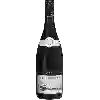
Château du HureauSaumur-Champigny Fours à Chaux
This wine generally goes well with pork, poultry or beef.
Food and wine pairings with Saumur-Champigny Fours à Chaux
Pairings that work perfectly with Saumur-Champigny Fours à Chaux
Original food and wine pairings with Saumur-Champigny Fours à Chaux
The Saumur-Champigny Fours à Chaux of Château du Hureau matches generally quite well with dishes of beef, pork or game (deer, venison) such as recipes of sweet and sour turkish dumpling soup (eksili köfte), rabbit with hunter's sauce or rabbit with mustard, thyme and cream.
Details and technical informations about Château du Hureau's Saumur-Champigny Fours à Chaux.
Discover the grape variety: Cabernet franc
Cabernet Franc is one of the oldest red grape varieties in Bordeaux. The Libourne region is its terroir where it develops best. The terroirs of Saint-Emilion and Fronsac allow it to mature and develop its best range of aromas. It is also the majority in many blends. The very famous Château Cheval Blanc, for example, uses 60% Cabernet Franc. The wines produced with Cabernet Franc are medium in colour with fine tannins and subtle aromas of small red fruits and spices. When blended with Merlot and Cabernet Sauvignon, it brings complexity and a bouquet of aromas to the wine. It produces fruity wines that can be drunk quite quickly, but whose great vintages can be kept for a long time. It is an earlier grape variety than Cabernet Sauvignon, which means that it is planted as far north as the Loire Valley. In Anjou, it is also used to make sweet rosé wines. Cabernet Franc is now used in some twenty countries in Europe and throughout the world.
Last vintages of this wine
The best vintages of Saumur-Champigny Fours à Chaux from Château du Hureau are 2014, 2011
Informations about the Château du Hureau
The Château du Hureau is one of of the world's greatest estates. It offers 11 wines for sale in the of Saumur-Champigny to come and discover on site or to buy online.
The wine region of Saumur-Champigny
The wine region of Saumur-Champigny is located in the region of Saumur of Loire Valley of France. Wineries and vineyards like the Domaine Clos Rougeard or the Domaine Clos Rougeard produce mainly wines red, white and pink. The most planted grape varieties in the region of Saumur-Champigny are Cabernet franc, Cabernet-Sauvignon and Chenin blanc, they are then used in wines in blends or as a single variety. On the nose of Saumur-Champigny often reveals types of flavors of smoke, grass or yellow apple and sometimes also flavors of tree fruit, oil or banana.
The wine region of Loire Valley
The Loire Valley is a key wine region in western France. It follows the course of the Loire River on its Long journey through the heart of France, from the inland hills of the Auvergne to the plains of the French Atlantic coast near Nantes (Muscadet country). Important in terms of quantity and quality, the region produces large quantities (about 4 million h/l each year) of everyday wines, as well as some of France's greatest wines. Diversity is another of the region's major assets; the styles of wine produced here range from the light, tangy Muscadet to the Sweet, honeyed Bonnezeaux, the Sparkling whites of Vouvray and the juicy, Tannic reds of Chinon and Saumur.
The word of the wine: Bitter (flavor)
A flavour generally provided in wines by polyphenols and accompanied by a sensation of pungency. In small quantities, bitterness makes you salivate, gives relief to the wine and reinforces its sapidity.














